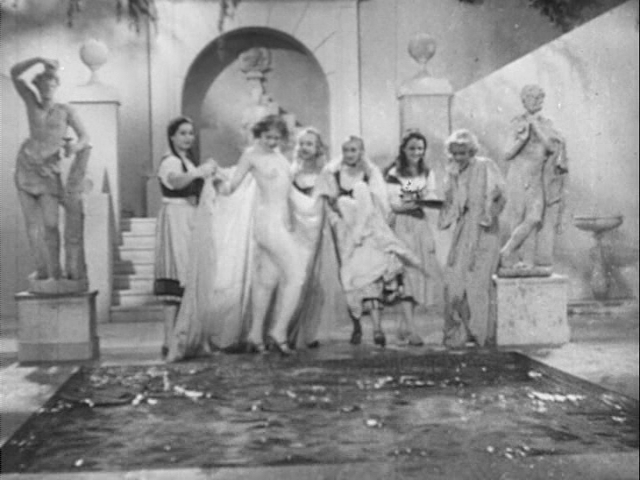
Above: Conrad Veidt as Cesare... again.
The Borgias, those incestuous, murderous schemers of the Italian Renaissance, are set to return to screens in a series starring Jeremy Irons. Which prompts the response, in me at least: "Jeremy Irons... are you sure?"
When did American culture turn inwards? Sometime following World War Two, I suspect. What I mean is, it was once understood that films set in exotic places and distant periods had an inherent appeal. Maybe this kind of escapism didn't constitute a real engagement with the wider world, but at least there was a kind of interest, so that a film with a title like Casablanca had obvious romance and attendant commercial possibilities attached to it. Perhaps the gradual availability of foreign travel at prices affordable to the general populace robbed the rest of the globe of its air of impossible glamor: Americans no longer cared to see such places on the screen. Nor, in many cases, did they care to go to them: minus their inaccessibility, what advantage did they offer over Peoria, Illinois?

Above: Paulette Goddard receives a not-so-brotherly kiss.
Tales of bloodsoaked European history used to be reliable box office: "In Italy for thirty years under the Borgias they had warfare, terror, murder and bloodshed..." says Orson Welles in The Third Man, with understandable enthusiasm. Also, poisoned powders administered via concealed compartments in chunky jewelry, and incestuous brother-sister subtexts. But by the time of Mitchell Leisen's Bride of Vengeance (1949), interest in such things was surprisingly low, and the filmmaker had to be more or less forced into making the thing. The script had been written as wartime escapism, then gathered dust for a few years, before finally being slung at the screen more or less in desperation. The resulting camp classic is nothing to be ashamed of: Paulette Goddard does the poisoning, Ray Milland is a bad guy in anatomically-correct armor, stuffing his face in every single scene (like Brad Pitt in Ocean's Eleven, only on Raymond it shows) and there's a very good phallic joke involving the hero and the world's largest cannon.
Once, you couldn't throw an envenomed stiletto at the screen without hitting a Borgia or two: John Barrymore battled the schemes of both brother and sister in Don Juan (1926), before riding off into the sunset with Mary Astor, uncharacteristically leaving them both alive (is it possible that Hollywood regarded some historical facts as inviolable?).

Above: Richard Oswald's Pope, a.k.a. Oz, the Great and Powerful.
This kind of nonsense was and on occasion still is, big in Europe. Richard Oswald's Lucrezia Borgia (1922) is a stunningly mounted, entirely overripe melodrama with Conrad Veidt as Cesare, a leering, eye-bulging psycho who kills any man who gets close to his sister. In his first scene, he extracts information by poisoning an enemy and dangling an antidote before him. The info obtained, Veidt delights in announcing that there was no poison: the first ever torture by placebo?

Above: Edwige.
Abel Gance made a talkie, Lucrèce Borgia (1935), something that never seemed to suit him, but he had the benefit of Edwige Feuillère stripping naked for a full-frontal flash. As with the Leisen film, this movie was surprisingly intent on preserving sympathy for its titular poisoner, and a lovable Lucrezia always seems something of a missed opportunity. Gance's leaden pacing ultimately sinks the film, but the Renaissance designs are lavish and ravishing.

Above: Martine Carol...I think.
In Christian-Jaque's Lucrèce Borgia (1953), there's barely any sympathy for anybody, which has negative dramatic effects but at least gives the whole cast a free hand to be as entertainingly atrocious as they please. Once again, copious and surprising nudity is the order of the day, with the director's wife, Martine Carol (Ophüls' Lola Montes) supplying much of it. There's also the full compliment of torture, assassination and dwarfish courtiers, plus an arresting scene where Lucrezia applies the split-open corpse of a dove to her face as a kind of exfoliant.
Such a bloody facial treatment calls to mind Countess Elizabeth Bathory, so it's not surprising to find both Lu and Liz in Walerian Boroczyk's Immoral Tales (1974), a piece of soft-focus erotic exotica which, apart from its highly accurate title, avoids any moral perspective whatsoever, giving Miss Borgia (Florence Bellamy) as much free rein as she could desire to be thoroughly wicked.
Perhaps that's another reason Hollywood has rather neglected tales of distant times and places: once, they provided an opportunity to indulge in the kind of nastiness beloved of audiences but frowned upon by the censor. With greater license to show terror and perversity on the screen, and an understanding aided by the news media that such things are not the exclusive province of decadent foreigners, American cinema no longer saw any need to situate sin in historically or geographically removed environments. Peoria, Illinois, would do just as well.
***
The Forgotten is a regular Thursday column by David Cairns, author of Shadowplay.